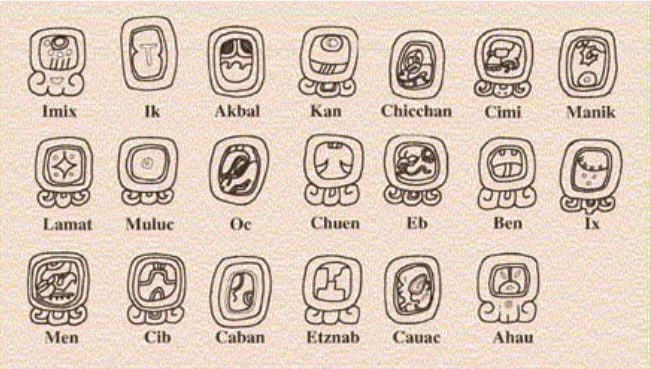Mayan Calendar

Mayan calendar Tzolkin (Depicted Above)
The Mayan calendar has various characteristics that are very similar to the Gregorian calendar that we follow in contemporary Western culture. It also had the concept of the “year”. In Mayan culture the solar year was called the “Haab” and it contained 365 days like the Gregorian solar year. and as in the case of the Gregorian calendar the year was divided into a number of “months” called “Uinals”. The months in the Mayan solar year were arbitrarily divided into twenty days each, and there was not an attempt at aligning them with the length of the lunar cycle as the Gregorian calendar does somewhat awkwardly. There was a lunar cycle record that was tallied separately and it was far more accurate in its accounting of the lunar month than the Gregorian calculations of 30 days and 31 days which we are used to.
The Mayas did not have a week with day names in the way that the Gregorian calendar does. They had a much more complex and richly mystical day-naming system that allowed them to pinpoint specific days and create elegant mythological constructs within their calendar. This was done through the use of a completely separate calendrical cycle which functioned parallel to the solar “haab” year. This cycle was an ancient complex now known as the “TZOLKIN”. The Tzolkin did not have any relationship with the solar cycle or any other naturally occurring astronomical cycle. It was more aligned with cycles that occur in the realm of fertility and birth. It was the cycle of creativity and Art. Many of the same mathematical principles that can be applied to the magical fractal artistry I mentioned earlier are inherent in the arithmetic of the Sacred Tzolkin. Ultimately, the mathematics of the Tzolkin, with its close affinity to the length of human gestation and the length of the maturation of maize corn is the mathematics of Life itself.
The arithmetic basis of the Tzolkin is the combination of two sacred numbers; 20 and 13. The product of these two numbers, 260 is the fundamental number in much of Mayan sacred mathematics.
Before even explaining how these numbers are used in the business of counting days, lets explore their mystical qualities. First and foremost we must accept the fact that when humans began to count their most readily accessible method of calculation was to count their fingers. This fact gives us our own decimal system (base ten) which honors the anatomical fact that humans have ten fingers and thumbs on both hands. However the Mayans recognized the occasional need to use the toes also and they developed a system that honored the anatomical fact of ten additional digits on the feet. This gave them a numbering system based on the number 20 called the “vigesimal” system.
Possessing a system that was based on a human anatomical reality gives the number 20 a very human feel. The very fact that the Mayan “month” is called the “uinal” honors the fact that it contains 20 days in the same way as a person (called “uinic” in ancient Mayan dialect) possesses 20 digits on his or her hands and feet.
The multiplication of the two sacred numbers: 20 and 13 produces a number; 260 which comes extremely close to the number of days in the nine-month gestation period of a human fetus. In fact, millions of children are born every year whose gestation lasts exactly 260 days.
In medieval times Europeans devised a notation system for writing music. This notation system assigned specific names to each note or tone of their octave, calling them “do”, “re”, “mi”, and so on. In the United States contemporary musicians now call these same notes “a”, “b”,”c” and so on but the notes are the same as the ones that were created long ago in the Middle Ages. The sounds that these notes represent can be measured scientifically and assigned specific descriptions by the use of a system called “frequency”. This system counts how many times per second a sound-producing membrane or string such as a guitar string of a clarinet reed has to vibrate to create that tone. If a tone is low-pitched it has fewer vibrations per second and the frequency number is low. If the tone is high-pitched it has a higher number of vibrations per second and the frequency is high.
Long ago musicians established a note that could stand at the middle of their overall musical range and provide the most accessible tone for the human voice. Since this note was at the very middle of the human range it was equally accessible to people with low-pitched voices such as most men and people with high-pitched voices such as children and most women. This note has come to be known as “middle C”. It stands right in the middle of the piano keyboard. It just so happens that this tone which represents the most accessible sound in human music has a frequency of 260 hertz. And so the number 260 surfaces as one of the most “human” numbers in the realm of arithmetic.
The fact that it takes 260 days for a certain kind of maize corn to mature and produce a harvest completes this image of the number 260 as being a fundamental element in the Mayan realm of human existence and sustenance.
The cycle of the twenty symbolic concepts, known as the “DaySigns” combine with the cycle of the thirteen numerical units or digits, known as “day numbers” to create a kind of meshing together in much the same way as two gears of different sizes intermesh.
The calendrical Tzolkin uses this combination of two numbers in a colorful and symbol-rich manner. The ancient Mayas produced a set of twenty mythological concepts and assigned a name to each one of these concepts. Later as they became more literate and began to represent their mythology and spirituality graphically they created a graphic image for each one of these concepts. This allowed them to write the twenty concepts down on paper or carve them on their buildings and monuments. They then imaged thirteen units to go along with these twenty concepts. The thirteen units allowed the Mayas to create the multiplication function that provided them with their magic number 260 (20 X 13=260)
